The Historic Hospitals Admission Records Project
The Historic Hospitals Admission Records Project (HHARP) is a digitisation and indexing project that covers the Victorian and Edwardian admission registers for the London children's hospitals Great Ormond Street Hospital (GOSH), the Evelina Children's Hospital in Southwark and the Alexandra Hip Hospital in Bloomsbury, together with Yorkhill Children's Hospital in Glasgow. It represents a collaboration between archivists, academics and volunteers that has resulted in a product that we hope will be of use to all those interested in the records of Victorian and Edwardian child health - from whichever academic discipline - or none [1].
It was conceived during a Wellcome-funded project Mortality in the Metropolis, (based at the Centre for Metropolitan History at the Institute of Historical Research) when the richness of the Great Ormond Street archive collection first became obvious to the researchers.
The original grant from the Wellcome-funded Library Co-operation and Partnership Programme enabled the registers from 1852 - 1903 to be microfilmed and copied. Further funding from the Wellcome Trust, the Nuffield Foundation, and the Friends of the Great Ormond Street Children's Hospital allowed the project to be extended to 1914, the inclusion of admissions to the hospital's convalescent home, Cromwell House, the digitisation of one set of surviving case notes, and the creation of a Web site to make the resulting data widely available.

Figure 1: Image of GOSH 1875
The Hospital for Sick Children at Great Ormond Street (GOSH) is Britain's oldest children's hospital. It was founded by Dr Charles West, a physician who had trained in London, France and Germany, and who was associated with the Children's Dispensary in Waterloo Road. After several failed attempts, Charles West finally succeeded in gaining support for his institution, and the Hospital for Sick Children was opened in February 1852. Its aims were to provide medical and surgical treatment for poor children, improve knowledge of childhood diseases and to train nurses to care for sick children. By the end of the century the hospital had almost 200 beds, plus another 50 at the convalescent home.
The initial objective of the project was to create a database of patients admitted to the hospital from its admissions registers for the period 1852 to the end of 1914, and from the registers of the convalescent home, and to link the two together to reconstruct the patient experience, albeit in a limited form.
In order to complete the project, it was necessary to join with an academic institution, and use the skills of volunteers to (at the very least) undertake the in-putting of data. Accordingly, the Centre for Local History Studies at Kingston University became the project's home. Staff already had experience of the processes involved in database creation from their work on the Kingston Local History Project (a large database of over 200,000 records of individuals residing in Kingston in the 19th century); moreover, they had a pool of keen volunteers and the experience to manage them. The database management methods and volunteer management experience were adapted for the GOSH project.

Figure 2: Image of Admission Register
The registers contain data on patients' names, age and place of residence, dates of admission and discharge, disease, names of doctors and governors, and the outcome of treatment, that is, whether the child was cured, relieved, not relieved or died.
Data Input
The original registers were filmed, and A3-sized photocopies were produced. Copies were then organised into batches of around 400 records. These records were allocated to volunteer data inputters who were issued with information packs about the hospital and the registers, and detailed instructions on interpretation. A specially created Microsoft Access input program was issued to each volunteer. They were instructed to enter data exactly as shown in the original, including any obvious mistakes, and not to make any individual interpretation. A Comments field was included where inputters could enter any information which could not be recorded within the structure of the database, or any comments they wished to make. Inputters were instructed to replace letters or words they could not decipher with three asterisks, rather than attempt a guess.
When completed, each batch was returned to the Centre and added to the master database. A checking printout was produced for teams of two volunteers, who made corrections where necessary. Intractable interpretation difficulties were referred to the hospital archivist, who supervised the final check against the original register. Only then were final corrections entered onto the master.

Figure 3: Volunteers in the CLHS at Kingston University
Validation and Standardisation
The process so far involved co-operation between three different groups, including a body of volunteers who became more proficient and confident as the project went on. At this point, a number of validation and enhancement procedures were undertaken. Dates, age, sex and forenames were checked for inconsistencies. The data was visually checked for erroneous entries such as letters in a numbers field, etc. Finally, the comments fields were checked for information which would affect any of the other fields in the entry.
By this stage, it was clear that we had to find the money and develop the expertise to create a searchable Web site. To this end, extra fields were added. For example, the length of stay was calculated from the admissions and discharge dates; and forenames, wards, doctors' names, diseases and places discharged to were standardised.
Standardisation of address information was of great importance, and two approaches were taken to facilitate a search or analysis of addresses: 30% of admissions were of children from outside the metropolis, although many of these were from places surrounding London which would now be considered part of greater London. These addresses were assigned a standard county. Addresses within London were dealt with in more detail, being assigned to registration districts and sub-districts. London, in this project, was the Metropolitan London area as defined in the Act for the Better Management of the Metropolis, 1855, and the registration districts used were those which fell into this definition. A registration and sub-registration district reference table was constructed using the data from the 1881 census. It is not entirely accurate, but when applied to address information in the database, admissions became searchable by discrete location within London. By using the same definition of London and its districts throughout the project, like-for-like comparisons can be made across time.
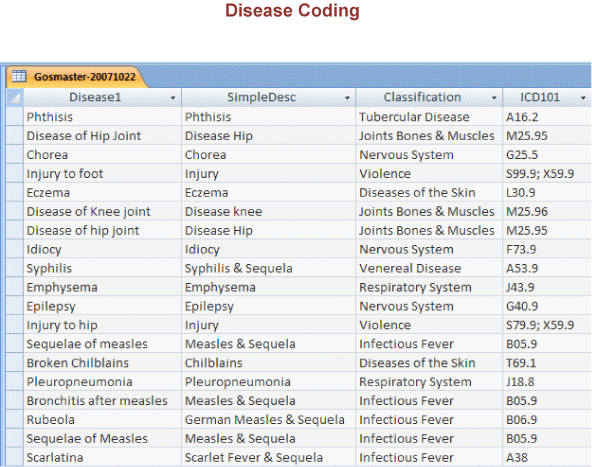
Figure 4: Table showing Disease Codes
Standardising disease information was also important, as there were so many different terms for individual diseases and a significant proportion of children had more than one disease or symptom recorded. A protocol for assigning a standard disease name was defined, based on symptoms and anatomical locations. For instance, the diagnosis in the Register may be written as 'knee disease' or 'abdominal abscess' or 'tumour of femur' etc. We first identified the symptom (e.g. 'Abscess' or 'Tumour' or 'Disease'), and added to that the body part affected. Certain exceptions would be for well-recognised disease entities such as Scarlet Fever, or Whooping Cough. These conditions were often referred to by several synonyms and one was selected as the standard for this database [2]. In addition, the diseases were classified using a system devised by the project team which was intended to reflect medical knowledge in the Victorian and Edwardian periods. It categorises diseases according to the body system affected, such as Circulatory System, Joints, Bones and Muscles, etc. Two major exceptions to this system are groupings for Tubercular Diseases and Infectious Fevers, which bring all incidence of these diseases into their respective categories, regardless of the body system affected.
For the benefit of modern-day epidemiologists, the International Classification of Diseases, or ICD10, compiled by the World Health Organisation and used by health administrators and epidemiologists around the world, has been applied to the data by an experienced GOSH Medical Coder [3]. Given the limited diagnostic information available, these codes have been applied as accurately as possible.
The admissions registers for the hospital's convalescent home were also entered onto a database, following the same process. These registers contain additional information on a patient's history of infantile diseases and vaccination. The Cromwell House admissions were linked to the GOSH admissions, enabling the user to locate patients at Cromwell House related to a GOSH admission, thus beginning to reconstruct the patient experience.
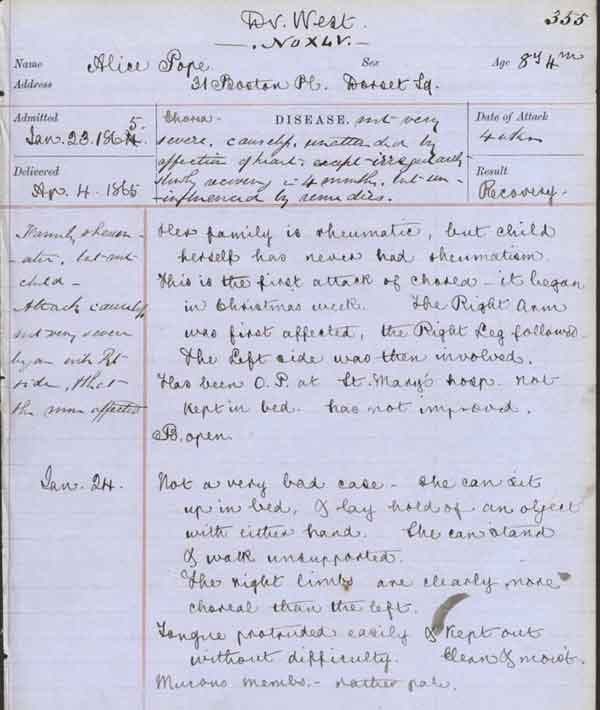
Figure 5: Case notes
The Great Ormond Street Hospital archive also contains a large number of volumes of case notes contemporary with these registers, and one set, belonging to Dr Charles West, covering the period 1854 to 1874, was selected to be digitised and linked to the relevant children in the registers. Almost 8,000 pages of scanned images of case notes were produced, and linked to 1,339 relevant admissions in the GOSH registers database
.
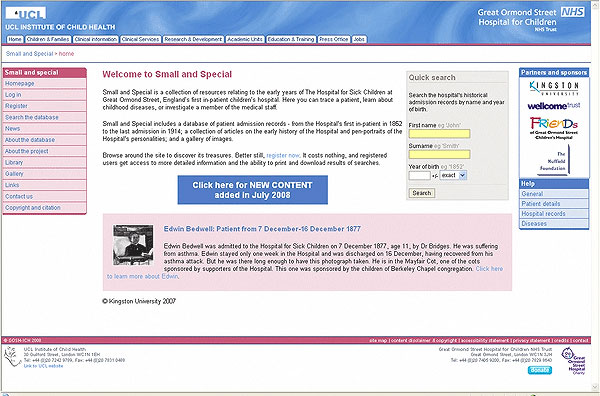
Figure 6: Screenshot of Project Web site home page
The final result of this work was a database containing almost 95,000 records, based on GOSH admissions, with their related admissions to (and from) the convalescent home, plus case notes. The data are now available via the project's Web site, "Small and Special" [4].
The database can be used to examine questions online about the children who were admitted, and illustrates how such sources can shed light not only on medical practice at the time, but on some of the social issues prevalent in Victorian and Edwardian London. We can use the database to pose 'typical' historians' questions: such as, who were the patients, how did the patient profile change over time, and what events might have influenced those changes?

Figure 7: Origins of GOSH patients
Let us consider the residence of the children who found themselves in the hospital . We can determine this by using the standardised information on home address which all patients provided on being admitted to the Hospital.
Perhaps unsurprisingly, a large number of children came from areas immediately adjacent to the Hospital itself, as the illustration shows: Holborn (where the Hospital was situated), St. Pancras and Islington providing one third of all admissions. Another third came from areas 'outside London', although most lived in districts that would now be considered as metropolitan [5]. To give an idea of what this means, both Tottenham and Walthamstow were considered to be 'Outside London'. Having said that, children did come from further away: from the south west, as far as Devon, as far north as Durham, a number from Wales and a handful from Scotland.
These are average figures across the period of the database, but comparing the mid- 19th century with the early 20th century we can see the averages hide a distinctive shift in patient profile:

Figure 8: Origins of GOSH Children II
This illustration compares the leading districts in 1852-1870 with those in 1902-1914. Still using the same definition of 'Outside London', in the early years, only 10% of patients gave addresses outside London. The leading districts of Holborn, St. Pancras and Islington contributed 45% of all admissions. By the beginning of the 20th century this picture had completely reversed: only 24% of patients came from these inner London districts, while 45% came from outside London. This huge shift is partly explained by the geographic growth of London itself, as more of the population moved to the once rural outer edges of the city.
However, a further element of this growth comes from the hospital's increasing reputation across the country, resulting in a growing number of children being sent from the provinces. And in this respect GOSH was competing with other children's hospitals. The foundation of very successful children's hospitals in Manchester in 1856 and Liverpool in 1859 might explain the lack of patients from Lancashire; but other hospitals such as those at Birmingham and Bristol did not prevent children being sent to GOSH from Wiltshire and Devon.
Within the central London areas we can also see a shift in the pattern of admissions: in the early period a significant number of children came from central districts such as St Giles (area 4 on the map). By the beginning of the 20th century this district sent very few children to the hospital, and perhaps this illustrates an effect of the late Victorian slum clearance programmes? Instead, we see an influx from the East End areas of Shoreditch and Whitechapel.
The Expansion of the Project
Having launched the Web site, it was clear that users - medical historians, in particular – would require other datasets to allow comparative studies. But there were none. So we decided to create them. In addition, the volunteers had developed an expertise that it would have been shameful to allow to lie fallow, and they themselves were keen to get on with the next project. Working with volunteers is hugely demanding, but the rewards are ample and enduring. One person at the Centre was responsible for keeping in touch with them, sending out e-newsletters, updates, advice and assistance. The social interaction is extremely important for volunteers, many of whom are retired, and who thrive on regular contact with their colleagues. Tea and biscuits for the office-based volunteers are as important as a working database, and social events help to keep up the momentum of any project [6].
As a result of the initial success, we gained further funding from the Wellcome Trust to expand the GOSH project to cover other children's hospitals nationwide. The Trust paid for Dr Sue Hawkins to scour the country, looking for suitable hospital admission registers. It was during this process that relationships with hospital and county archivists were begun and nurtured. As a result of her summer of travel, we identified six hospitals that had records suited to the same process. Of these, we have worked on, or are working on, the Alexandra Hip Hospital, the Evelina Hospital for Sick Children, and The Royal Glasgow Sick Children's Hospital (Yorkhill).
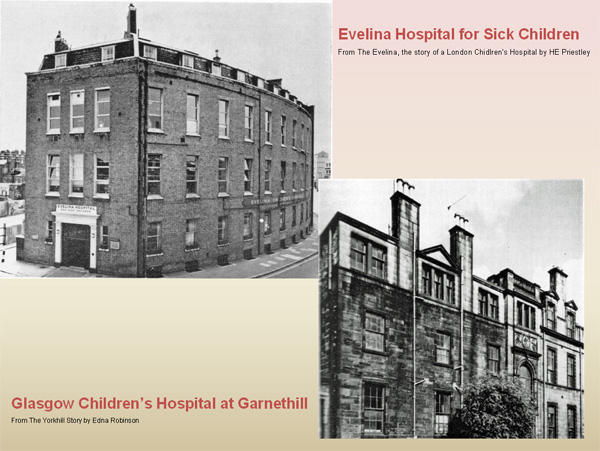
Figure 9: Yorkhill & Evelina hospitals
The approach in respect of Yorkhill demonstrates the development of techniques, and a greater involvement on the part of the archivist than was possible with the other two London hospitals. Most importantly, when it was discovered that a Yorkhill register was missing, we worked closely with archivist Alma Topen to recreate (in effect) the missing register from a variety of other sources in her care. We found local volunteers to work on the material, and the archivist has been delighted that local awareness of her collection has been raised to a great extent. It is hoped that the relationship the hospital archive enjoys with local volunteers will be expanded and enduring, to cover projects that she herself wishes to launch.
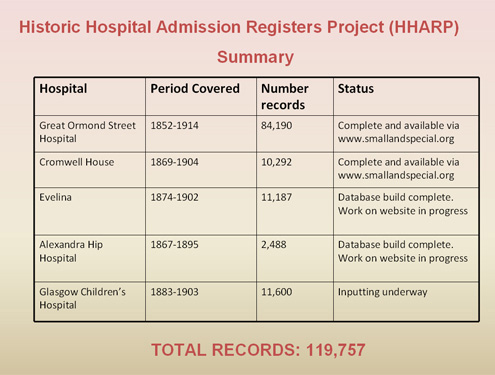
Figure 10: Status Quo of HHARP, 2009
Conclusion
If we were to be transported back in time to 1999, when the project was in its embryonic form, there are many things that we would do differently. As the Irish say, if you want to get somewhere, don't start from here. At the dawn of the Millennium, Web sites were rather exotic, and we had no plans to create one. We expected that our users would be those accustomed to sending queries into archive offices, and that Kingston and the hospital archivist would conduct most of the database searches on behalf of the searchers. We also expected to create discs for academic researchers and epidemiologists, with specialised interests. Today, users demand access to the data for themselves, with links to relevant sites, and large amounts of extra contextual information. There are several prosopographical Web sites now available, although most have been created by academics for their peers, and none has used volunteers to the same extent as the HHARP project [7]. Nowadays, it is not enough to create a Web site. One must create one's resource, and make it available on a Web site that enables user feedback, user contributions and corrections, and, moreover, that will engage and inspire them.
We have not ended the project, and we wonder sometimes if we ever shall. The more we make available, the greater the feedback, and the greater the demand. Users have sent in the results of their own researches, adding to the fund of knowledge on hospital patients and staff to be included on the Web site. Technological developments in intelligent scanning, tagging and metadata embedding mean that it is possible to consider expanding the methodology to cover more records, and different types of material. The Heritage at Home movement means that more volunteers can be used, who can be based anywhere in the world, and their efforts combined to create resources of unimaginable size and accessibility.
We are now researching parental occupations for inclusion on the site, and we are trying to find the funds to expand the digital casenotes collection to give greater insight into the hospital experience of more patients. The project has expanded to cover other children's hospitals in the UK, and we are now considering extending further to include general hospitals, workhouse infirmaries, and other medical institutions. We recognise that it is no longer enough to create a Web site containing the data you have accumulated during the time a project has been funded; it is now necessary to look at value-added technological advances in order to attract funding. To this end, we are looking at ways of involving academic institutions, of widening departmental involvement, and of creating tools that can be applied by archives of all types to their own holdings, in order to open them out to users of all persuasions. One of the first examples of multi-disciplinary spin-off projects is a joint venture between the Centre for Local History Studies (CHLHS), the School of Education at Kingston University and the London Grid for Learning. This project, codenamed HeLP, is currently in production and will result in an online teaching and learning resource for use in primary schools in History Key Stages I and II.
Whatever happens, we are committed to involving archivists, volunteers and archive users to the maximum, and to fostering co-operation across the archival – and non-archival – communities.
References
- Several articles have come from the project. See Tanner, Andrea. 'Choice and the children's hospital : Great Ormond Street Hospital patients and their families 1855–1900' "Medicine, charity and mutual aid : the consumption of health and welfare in Britain, c.1550-1950. In Borsay, Anne; Shapely, Peter (ed.), Medicine, charity and mutual aid : the consumption of health and welfare in Britain, c.1550-1950 (Historical urban studies series) (Aldershot: Ashgate, 2007), 135-62. ISBN 9780754651482; 0754651487.
http://www.rhs.ac.uk/bibl/wwwopac.exe?DATABASE=dcatalo&LANGUAGE=0&OPAC_URL=&SUCCESS=false&rf=200706261 - For example, Whooping Cough was chosen as the standard term for a disease also frequently referred to as Pertussis, or spelt 'Hooping Cough'.
- For a detailed explanation of ICD 10, see WHO: International Classification of Diseases (ICD) http://www.who.int/classifications/icd/en/
- Small and Special http://www.smallandspecial.org/
- For maps of the London conurbation in the Victorian and modern-day periods, see
http://www.londonancestor.com/maps/maps.htm
http://archivemaps.com/mapco/london.htm and
http://www.cityoflondon.gov.uk/.../maps/london_map.htm - Volunteers are an integral part of community archive work, and there is a strong volunteer tradition in oral history projects, but they have rarely been used by universities until now.
- The most well-known prosopographical databases include:
the Clergy of the Church of England http://www.theclergydatabase.org.uk/index.html
Old Bailey Online http://www.oldbaileyonline.org/
The Prosopography of the Byzantine World http://www.pbw.kcl.ac.uk/pbw/apps/
and the Prosopography of Anglo Saxon England http://www.pase.ac.uk/
